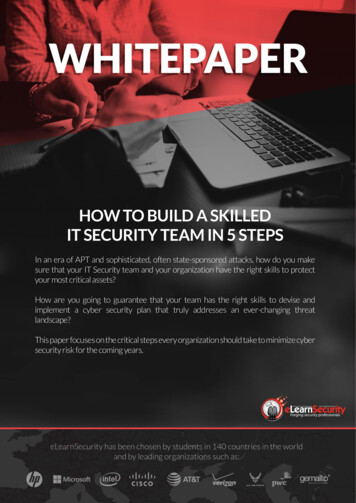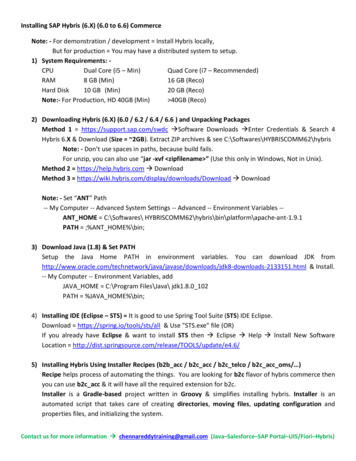
Transcription
HOW TO BUILD A SKILLEDIT SECURITY TEAM IN 5 STEPSIn an era of APT and sophisticated, often state-sponsored attacks, how do you makesure that your IT Security team and your organization have the right skills to protectyour most critical assets?How are you going to guarantee that your team has the right skills to devise andimplement a cyber security plan that truly addresses an ever-changing threatlandscape?This paper focuses on the critical steps every organization should take to minimize cybersecurity risk for the coming years.
BUDGET TRENDSFor the past few decades, corporations andgovernments have poured hundreds of billions of dollarsinto security hardware and software, only to discoverthat their critical infrastructure is still vulnerable toattack vectors which have been discovered and welldocumented twenty or more years ago. For years, wethought that cybersecurity was a software or ahardware problem. It’s not.It’s a people problem: people who sell you nextgeneration security devices; people who buy them, and ultimately, peoplewho operate, configure, and maintain them.According to PwC, Incidents (successful attacks) increased by 38% over theprevious year (2015), confirming a trend that has been steady for the past fewyears: “Cyber attacks continue to escalate in frequency, severity and impact.Prevention and detection methods have proved largely ineffective againstincreasingly adept assaults”1.Despite common belief, technology alone isnot winning over cybercrime.Is this because corporations andgovernments do not invest enough intoCyber Security?In a recent 10-K SEC filing2, JP Morgan Chase, thelargest bank in the US – and the sixth in the world –announced that they budgeted 600 million forcyber security in 2016. Compared to 500M in2015 and 250M in the previous year, that it is anincrease of over 100% in 2 years alone.1 PwC. (2016). The Global State of Information Security Survey 2016. Retrieved state-of-information-security-survey.html2 JPMorgan Chase & Co. (2015, December 31). Form 10-K. Retrieved /sec.cfmOur training courses: www.elearnsecurity.com/course Caendra Inc. 2017
Despite this, Andy Cadel, general counsel, IP and data protection for JP MorganChase, told Bloomberg3 that they still feel “challenged,” so much so that they listcyber security as one of the primary risks for their investors.Bank of America’s approach was to adapt a no-limit budget for cyber security. Inthe words of its CEO, Brian Moynihan, “this is the only place in the company thatdidn't have a budget constraint” 4.While still under President Obama, the White House set a 19-billion budget forcyber security for FY 2017, up 35% from FY 20165. Such figures will probably beconfirmed, if not increased by the new Trump administration.IT Security budgets throughout the mosttargeted industries such as financial, retailand defense are steadily growing and will befor the foreseeable future.Why, if budgets are on the rise, can’t we fix, or at least minimize, the cybersecurity problem?3 Friedman, G. (2016, January 29). JPMorgan Chase Atty: Bank Will Spend 500M on Cyber Security.Business. Retrieved from https://btol.bna.com/4 Schatzker, E., Ruhle, S. (2015, January 21). Moynihan: BofA Cybersecurity Unit Has Blank Check.Big LawBloomberg.Retrieved from https://www.bloomberg.com5 The White House, Office of the Press Secretary. (2016). Cybersecurity National Action Plan [Press Release].Retrieved from tion-planOur training courses: www.elearnsecurity.com/course Caendra Inc. 2017
HOW BUDGETS ARE SPENTAccording to the IDC, almost 70% of the overall ITsecurity budget in 2016 has been spent on ManagedSecurity Services (MSS) or Hardware / Software6.A survey on more than 200 enterprise securityprofessionals contained in Accenture’s State ofCybersecurity and Digital Trust 2016 revealed:“Cybersecurity teams are struggling, with 42 percentof respondents believing that while they have enoughbudget for security technology, they need additionalbudget for hiring security talent and training.”7This is in-line with other research8 9 that project a shortage of between 1.5 and 2million cyber security professionals by 2019, making skilled IT securityprofessionals highly sought-after and hard to find.In the words of Robert Herjavec, Founder and CEO of Herjavec Group, a ManagedSecurity Services Provider: “Unfortunately the pipeline of security talent isn’twhere it needs to be to help curb the cybercrime epidemic.”He goes on to say “Until we can rectify the quality of educationand training that our new cyber expertsreceive, we will continue to be outpaced bythe Black Hats.”6 IDC. (2016). Worldwide Semiannual Security Spending Guide. Retrieved from https://www.idc.com/home.jsp7 Accenture. (2016). The State of Cybersecurity and Digital Trust 2016. Retrieved ecurity-digital-trust-20168 ISACA. (2017). Survey: Cyber Security Skills Gap Leaves 1 in 4 Organizations Exposed for Six Months or Longer[Press Release]. Retrieved from hs-orLonger.aspx9 Morgan, S. (2016, January 2). One Million Cybersecurity Job Openings in 2016. Forbes. Retrieved fromhttps://www.forbes.com/Our training courses: www.elearnsecurity.com/course Caendra Inc. 2017
CHANGES IN THE THREAT LANDSCAPEThe threat landscape is continuously evolving.Large organizations are now facing attacks at an unprecedented level ofsophistication. State-sponsored attacks, cyber-espionage from competition andAPTs in general, all leverage 0-days, stealthy techniques, and “slow-cooked”exfiltration techniques, that make intrusion detection a matter of months, if notyears.Time to detect, and time to remediate aretwo of the most important cyber securitymetrics and are worsening as a result.Our training courses: www.elearnsecurity.com/course Caendra Inc. 2017
According to a Deloitte analysis of breaches in financial industry organizations, 88%of the time, attackers successfully breach a company in a matter of hours. 10While in 38% of the cases, it takes months oreven years for that organization to discoverthe incident!A BLENDED APPROACH TO SECURITYOrganizations need to have skills, ranging from security awareness to the mostadvanced hacking techniques, to be prepared to combat sophisticated attacks.By having a workforce with practical skills on cyber security, an organization will beable to: Properly evaluate risk based on facts rather than on next-generation UTMmarketing collaterals. Perform internal audits that can mimic advanced persistent threats and canconfidentially uncover security pitfalls within the organization. Hunt for adversaries to drastically decrease the discovery time and thechances that digital information gets exfiltrated. Drastically decrease the effectiveness of social engineering and spearphishing attacks.A skilled IT Security team helps: reduce timeto detect, time to resolve and risk per host.This translates in an improved securityposture.10 Deloitte. (2014). Transforming cybersecurity. Retrieved formingCybersecurity-2014-02.pdfOur training courses: www.elearnsecurity.com/course Caendra Inc. 2017
5 STEPS TO A SKILLED IT SECURITY TEAMIT Security has such a vast knowledge domain that building in-house skills mightlook overwhelming, time consuming, and expensive.The following are 5 steps an organization can take to drastically improve theirsecurity posture while maintaining efficiency and controlling training costs.1Define Essential Team RolesTo begin with, the IT Security team should have a clear separation ofresponsibilities, and each member should have a clear career path, matched withproper training.Whether the team is large or small, the following logical separation helps in definingroles and required skills: The Security Engineering Team is involved at design time, to install,configure, and operate security software and hardware. This team is alsoresponsible for hardening systems and applying patches. The Proactive or Red Team is involved with proactive auditing andpenetration testing of systems, simulating sophisticated external andinternal adversaries with the goal of uncovering vulnerabilities and testingdefenses. The Blue Team is involved with the monitoring, response, investigation, andanalysis of security incidents. Also known as the Intrusion Detection andResponse Team, it often becomes an extension to the engineering team inundertaking defensive roles, while benefiting from the presence of the Redteam, and improving day-by-day operation with the Red Team’s input. Management defines strategic goals for the entire team, based on theorganization’s IT Security needs and objectives. This strategy shouldtranslate into security policies, hiring plans, training plans, budgeting, andperformance review.Having a clear logical segmentation of the IT Security team is the first step towardsbuilding competencies that are relevant to the roles of each member.Our training courses: www.elearnsecurity.com/course Caendra Inc. 2017
2Lay Common Ground (Practical) SkillsRegardless of the roles covered in your IT Security team, there are certain skills thatare relevant across the board. Without proper practical training in those skills, anytraining effort would be ineffective.A practical understanding of today’s threats is critical not only to members of theRed Team but also to: Blue Team / security engineers Security managersSecurity engineers and members of the Blue Team deal with cyber threats everyday. Their understanding of the practical aspects of cyber threats is imperative toproperly and readily respond and remediate.Security managers are responsible for planning security initiatives based on factsrather than vendors’ marketing. This is done by relying on their own team’sadvanced practical skills. It gives them the skills to better assess, evaluate, and makedecisions.Practical training for everyone involved in defensive and offensive roles within anIT Security team should include the following areas: Network attack techniques Web application and Mobile attack techniques Modern malware (e.g. ransomware) analysis Covert channels and other APT techniquesOur training courses: www.elearnsecurity.com/course Caendra Inc. 2017
3Define Training PathsIT Security requires a high degree ofspecialization. There is no single training thatcan make anyone a professional in anysubject. But there are training paths, a seriesof time-tested training courses, that canmake someone with the right foundationskills, a hands-on proficient professional.Very advanced roles such as Penetration Tester, Threat Hunter or Digital ForensicAnalyst require a series of competencies that cannot be built in a 5-day classroomtraining.The following is a non-exhaustive map of competencies that each role in an ITSecurity team should have.Our training courses: www.elearnsecurity.com/course Caendra Inc. 2017
Our training courses: www.elearnsecurity.com/course Caendra Inc. 2017
By using the above map, a security managercan perform a skills gap analysis and settraining goals for each of their members on amid-term (1 to 3 years) basis.4tGo for Practical TrainingOnce the security manager has devised asolid training plan for their team, whichtraining is the next decision. This decision isof vital importance.The goal is to have the team proficient at work as soon as possible – so, as in anyother business decision, it boils down to a risk/benefit analysis: How soon can the team be ready to apply the learned techniques at work? How effective is the training delivery method? How much does it cost the company?Practical training based on sophisticatedvirtual labs immerses the student in manydifferent real-world situations in which acyber security problem should be solved.Our training courses: www.elearnsecurity.com/course Caendra Inc. 2017
These “situations”, also called virtual lab scenarios, are specifically built by subjectmatter experts to effectively transfer hard-earned experience in a matter of hours.For years, military and defense organizations have benefited from such technologyin their cyber-ranges. This technology is available today for organizations of allsizes and at a reasonable cost.Moreover, practical training that is also self-paced is the best solution, when theorganization wants to immediately acquire internal skills, while having the flexibilityof allocating training time when it makes more sense to the company.Virtual labs that are isolated, realistic and ondemand provide the best �spracticalAs a security manager or team leader,measuring performances helps build theROTI (Return on Training Investment) andobtain valuable feedback on where yourteam needs to focus the most.But how do successful managers measure competencies?How can one be 100% sure of the skills effectively acquired by attending a giventraining – especially if it’s online/self-paced?Our training courses: www.elearnsecurity.com/course Caendra Inc. 2017
The answer is: Practical certificationprograms that assess the practical skillsacquired by the student in that knowledgedomain.IT Security, just like any other extremely technical field, is a domain where practicalproficiencies cannot be assessed through multiple choice exams, because they donot capture how the IT Security professional will behave in a real, often hectic,situation of a cyber-attack.The industry and its old-fashioned certification schemes are now shifting towardspractical assessments, where candidates give proof of their abilities throughobtaining certifications, that not only bring value to the company, but also theindividual.Our training courses: www.elearnsecurity.com/course Caendra Inc. 2017
We are eLearnSecurity.Based in Santa Clara, California and with offices in Pisa, Italy and Dubai, UAE,Caendra Inc. is a trusted source of IT security skills for IT professionals andcorporations of all sizes. Caendra Inc. is the Silicon Valley-based company behind theeLearnSecurity brand.eLearnSecurity has proven to be a leading innovator in the field of practical securitytraining. Best of breed virtualization technology, in-house projects such as ColiseumWeb Application Security Framework and Hera Network Security Lab, have changedthe way students learn and practice new skills.Contact rity.com
Organizations need to have skills, ranging from security awareness to the most advanced hacking techniques, to be prepared to combat sophisticated attacks. By having a workforce with practical skills on cyber security, an organization will be able to: Properly evalua











